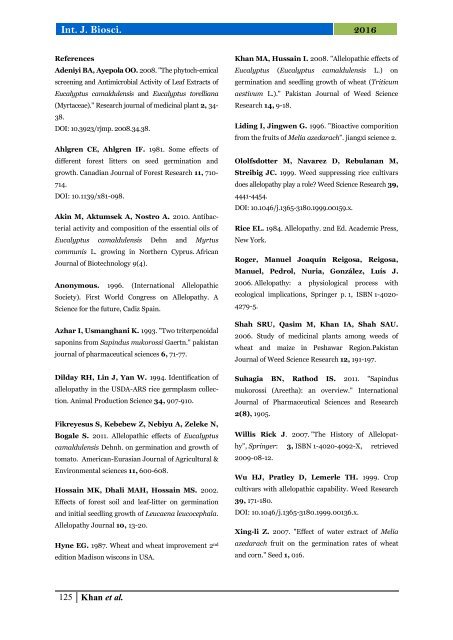Allelopathic effect of some tree fruits on wheat (Triticum Aestivum L.)
An experiment was conducted to determine the allelopathic potentials of fruits of different plant species on the germination of wan heat variety Pir Sabaq 2005. The experiment was laid out in completely randomized design (CRD) with three treatments and four replications. The aqueous solution of fruits of three plant species including Eucalyptus camaldulensi, Melia azedarach and Sapindus mukorossi were applied on wheat germination. All treatment significantly decrease the plumule and radical length as compare to control that is TO. Maximum root length was observed in control while minimum root length was observed in wheat due to aqueous fruit extract of Melia azedarach. Maximum length of seedling of wheat was observed in control while minimum seedling length was observed by extract of Melia azedarach. Allelopathic effect of fruit on root length can be represented as To> Sapindus mukorossi> Eucalyptus camaldulensis> Melia azedarach and same effect was observed in seedling length that can be shown as To > Eucalyptus camaldulensis> Sapindus mukorossi> Melia azedarach. It c concluded that fruit of Melia azedarach are more toxic and has inhibitory effect on germination of wheat as compare to other trees. This tree should not be planted near to crop because during germination period that is November their fruits become mature and fall down in field of wheat and produce aqueous extract due to action of rain water and ultimately decrease the germination.
An experiment was conducted to determine the allelopathic potentials of fruits of different plant species on the germination of wan heat variety Pir Sabaq 2005. The experiment was laid out in completely randomized design
(CRD) with three treatments and four replications. The aqueous solution of fruits of three plant species including Eucalyptus camaldulensi, Melia azedarach and Sapindus mukorossi were applied on wheat germination. All
treatment significantly decrease the plumule and radical length as compare to control that is TO. Maximum root length was observed in control while minimum root length was observed in wheat due to aqueous fruit extract of
Melia azedarach. Maximum length of seedling of wheat was observed in control while minimum seedling length was observed by extract of Melia azedarach. Allelopathic effect of fruit on root length can be represented as To> Sapindus mukorossi> Eucalyptus camaldulensis> Melia azedarach and same effect was observed in seedling length that can be shown as To > Eucalyptus camaldulensis> Sapindus mukorossi> Melia azedarach. It c
concluded that fruit of Melia azedarach are more toxic and has inhibitory effect on germination of wheat as compare to other trees. This tree should not be planted near to crop because during germination period that is November their fruits become mature and fall down in field of wheat and produce aqueous extract due to action of rain water and ultimately decrease the germination.
Create successful ePaper yourself
Turn your PDF publications into a flip-book with our unique Google optimized e-Paper software.
Int. J. Biosci. 2016<br />
References<br />
Adeniyi BA, Ayepola OO. 2008. "The phytoch-emical<br />
screening and Antimicrobial Activity <str<strong>on</strong>g>of</str<strong>on</strong>g> Leaf Extracts <str<strong>on</strong>g>of</str<strong>on</strong>g><br />
Eucalyptus camaldulensis and Eucalyptus torelliana<br />
(Myrtaceae)." Research journal <str<strong>on</strong>g>of</str<strong>on</strong>g> medicinal plant 2, 34-<br />
38.<br />
DOI: 10.3923/rjmp. 2008.34.38.<br />
Ahlgren CE, Ahlgren IF. 1981. Some <str<strong>on</strong>g>effect</str<strong>on</strong>g>s <str<strong>on</strong>g>of</str<strong>on</strong>g><br />
different forest litters <strong>on</strong> seed germinati<strong>on</strong> and<br />
growth. Canadian Journal <str<strong>on</strong>g>of</str<strong>on</strong>g> Forest Research 11, 710-<br />
714.<br />
DOI: 10.1139/x81-098.<br />
Akin M, Aktumsek A, Nostro A. 2010. Antibacterial<br />
activity and compositi<strong>on</strong> <str<strong>on</strong>g>of</str<strong>on</strong>g> the essential oils <str<strong>on</strong>g>of</str<strong>on</strong>g><br />
Eucalyptus camaldulensis Dehn and Myrtus<br />
communis L. growing in Northern Cyprus. African<br />
Journal <str<strong>on</strong>g>of</str<strong>on</strong>g> Biotechnology 9(4).<br />
An<strong>on</strong>ymous. 1996. (Internati<strong>on</strong>al <str<strong>on</strong>g>Allelopathic</str<strong>on</strong>g><br />
Society). First World C<strong>on</strong>gress <strong>on</strong> Allelopathy. A<br />
Science for the future, Cadiz Spain.<br />
Azhar I, Usmanghani K. 1993. "Two triterpenoidal<br />
sap<strong>on</strong>ins from Sapindus mukorossi Gaertn." pakistan<br />
journal <str<strong>on</strong>g>of</str<strong>on</strong>g> pharmaceutical sciences 6, 71-77.<br />
Dilday RH, Lin J, Yan W. 1994. Identificati<strong>on</strong> <str<strong>on</strong>g>of</str<strong>on</strong>g><br />
allelopathy in the USDA-ARS rice germplasm collecti<strong>on</strong>.<br />
Animal Producti<strong>on</strong> Science 34, 907-910.<br />
Fikreyesus S, Kebebew Z, Nebiyu A, Zeleke N,<br />
Bogale S. 2011. <str<strong>on</strong>g>Allelopathic</str<strong>on</strong>g> <str<strong>on</strong>g>effect</str<strong>on</strong>g>s <str<strong>on</strong>g>of</str<strong>on</strong>g> Eucalyptus<br />
camaldulensis Dehnh. <strong>on</strong> germinati<strong>on</strong> and growth <str<strong>on</strong>g>of</str<strong>on</strong>g><br />
tomato. American-Eurasian Journal <str<strong>on</strong>g>of</str<strong>on</strong>g> Agricultural &<br />
Envir<strong>on</strong>mental sciences 11, 600-608.<br />
Hossain MK, Dhali MAH, Hossain MS. 2002.<br />
Effects <str<strong>on</strong>g>of</str<strong>on</strong>g> forest soil and leaf-litter <strong>on</strong> germinati<strong>on</strong><br />
and initial seedling growth <str<strong>on</strong>g>of</str<strong>on</strong>g> Leucaena leucocephala.<br />
Allelopathy Journal 10, 13-20.<br />
Hyne EG. 1987. Wheat and <strong>wheat</strong> improvement 2 nd<br />
editi<strong>on</strong> Madis<strong>on</strong> wisc<strong>on</strong>s in USA.<br />
Khan MA, Hussain I. 2008. "<str<strong>on</strong>g>Allelopathic</str<strong>on</strong>g> <str<strong>on</strong>g>effect</str<strong>on</strong>g>s <str<strong>on</strong>g>of</str<strong>on</strong>g><br />
Eucalyptus (Eucalyptus camaldulensis L.) <strong>on</strong><br />
germinati<strong>on</strong> and seedling growth <str<strong>on</strong>g>of</str<strong>on</strong>g> <strong>wheat</strong> (<strong>Triticum</strong><br />
aestivum L.)." Pakistan Journal <str<strong>on</strong>g>of</str<strong>on</strong>g> Weed Science<br />
Research 14, 9-18.<br />
Liding I, Jingwen G. 1996. "Bioactive comporiti<strong>on</strong><br />
from the <str<strong>on</strong>g>fruits</str<strong>on</strong>g> <str<strong>on</strong>g>of</str<strong>on</strong>g> Melia azedarach”. jiangxi science 2.<br />
Ololfsdotter M, Navarez D, Rebulanan M,<br />
Streibig JC. 1999. Weed suppressing rice cultivars<br />
does allelopathy play a role? Weed Science Research 39,<br />
4441-4454.<br />
DOI: 10.1046/j.1365-3180.1999.00159.x.<br />
Rice EL. 1984. Allelopathy. 2nd Ed. Academic Press,<br />
New York.<br />
Roger, Manuel Joaquín Reigosa, Reigosa,<br />
Manuel, Pedrol, Nuria, G<strong>on</strong>zález, Luís J.<br />
2006. Allelopathy: a physiological process with<br />
ecological implicati<strong>on</strong>s, Springer p. 1, ISBN 1-4020-<br />
4279-5.<br />
Shah SRU, Qasim M, Khan IA, Shah SAU.<br />
2006. Study <str<strong>on</strong>g>of</str<strong>on</strong>g> medicinal plants am<strong>on</strong>g weeds <str<strong>on</strong>g>of</str<strong>on</strong>g><br />
<strong>wheat</strong> and maize in Peshawar Regi<strong>on</strong>.Pakistan<br />
Journal <str<strong>on</strong>g>of</str<strong>on</strong>g> Weed Science Research 12, 191-197.<br />
Suhagia BN, Rathod IS. 2011. "Sapindus<br />
mukorossi (Areetha): an overview." Internati<strong>on</strong>al<br />
Journal <str<strong>on</strong>g>of</str<strong>on</strong>g> Pharmaceutical Sciences and Research<br />
2(8), 1905.<br />
Willis Rick J. 2007. "The History <str<strong>on</strong>g>of</str<strong>on</strong>g> Allelopathy",<br />
Springer: 3, ISBN 1-4020-4092-X, retrieved<br />
2009-08-12.<br />
Wu HJ, Pratley D, Lemerle TH. 1999. Crop<br />
cultivars with allelopathic capability. Weed Research<br />
39, 171-180.<br />
DOI: 10.1046/j.1365-3180.1999.00136.x.<br />
Xing-li Z. 2007. "Effect <str<strong>on</strong>g>of</str<strong>on</strong>g> water extract <str<strong>on</strong>g>of</str<strong>on</strong>g> Melia<br />
azedarach fruit <strong>on</strong> the germinati<strong>on</strong> rates <str<strong>on</strong>g>of</str<strong>on</strong>g> <strong>wheat</strong><br />
and corn." Seed 1, 016.<br />
125 Khan et al.


















